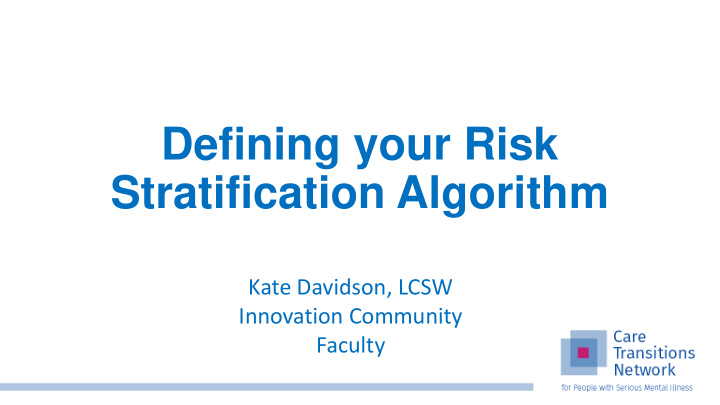



Defining your Risk Stratification Algorithm Kate Davidson, LCSW Innovation Community Faculty
Presenter Kate Davidson, LCSW Innovation Community Faculty Assistant Vice President, Practice Improvement National Council for Behavioral Health KateD@TheNationalCouncil.org
Learning Objectives By the end of this webinar, participants will understand how to: • Define population health management and risk stratification • Analyze and ask the most pertinent and relevant questions about their patient populations • Develop a risk stratification algorithm using indicators that effectively identify high-risk patients
Audience Poll What is your role in your organization?
Assembling Your Team Consider including the following roles/departments on your risk identification team: • Information Technology • Quality Improvement • Clinical Supervisors • Therapists • Senior Leadership • Practice Management • Billing • Utilization Review Who is on your team?
Aligning our Terms! Value-based Payments requires… Care Pathways which requires… Risk Stratification which requires… Population Health Management therefore… these concepts are not loosely linked but are structurally contingent on one another
Low Hanging Fruit • What is your algorithm to identify risk • How do your clinicians understand the problem • How will you collect this data • Who will collect this data • How will you disseminate this data • What do your clients view as the biggest contributing factors
A metric accurately reflects work if…. When metric Data can be changes the collected with cause & modest effort required from source actions are that is trusted clear ACCESSIBLE & ACTIONABLE CREDIBLE DATA GOOD METRIC TRANSPARENT & COMMON SIMPLE TO INTERPRETATION CALCULATE Method for generating Staff know metric is what the shared & well metric means understood
Numerator & Denominator Numerator = The count of instances that the issue under review happened - 23 people have a risk classification Denominator = the entire population under review - 100 people were supposed to have a risk classification
Types of Metrics Process Measures explain how the system works - % of high risk people who were referred to health home/care coordination - % of high risk people who were seen in the last two weeks Outcome Measures explain the effectiveness of the system - % of people who improved from ‘high’ risk to ‘low’ risk in 6 months
Audience Poll What are some of the ways you are identifying risk?
How to Identify Risk Population data • Raw Data from EHR/EMR/other Data Risk level data source Determine Risk Level • Calculate High or Low Risk based on an algorithm Calculate Risk Stratify by Risk • Population data and risk level Risk Calculation Stratify • Analyze data and stratify population by risk
Risk Stratification The Care Transitions Network’s Data Risk level Risk Stratification Tool is an Excel workbook that enables providers to: • Stratify risk • Identify trends Stratify by Risk • Track outcomes over time Risk Calculation …At the population level
Risk Indicators These indicators are used to Diagnosis identify risk in our algorithm : Medical Hospitalization Alone, these indicators Comorbidities History will help determine risk, but only the Transformed combination of these Data Tab indicators will tell the complete story Emergency Social Department Determinates of Utilization Health History
Backing Up to Make The Logic Model • A small portion of our patient population are high utilizers of our hospital systems • High utilizers are not receiving treatment that is effectively impacting their disease state • High utilizers have a tremendous cost impact on the system • Need a methodology to identify these high risk clients and systematically target improved wellness
Audience Poll What is one goal that you will complete by the end of this innovation community?
Low Hanging Fruit • What is your algorithm to identify risk • How do your clinicians understand the problem • How will you collect this data • Who will collect this data • How will you disseminate this data • What do your clients view as the biggest contributing factors
Workflow IT Manager Extracts Data Monthly IT Manager Distributes Reports to C-Suite, Director, Supervisors, Therapists Monthly Director Reports Data Therapist Analyzes Data Supervisors Review Data Trends with C-Suite with Supervisors Trends with Director Team
Call to Action Prior to the next meeting, complete these action steps: • Assemble your team • Develop a three month project plan • Identify the populations your are currently serving • Identify indicators that will be the foundation for your algorithm
Audience Poll Will you commit to this action plan?
RS Innovation Community Events Event Date/Time Audience Webinar # 1: Population Health Thursday, 7/26, 11:30 am – 12:30 pm Clinical Directors Management: Building a Risk Stratification E.T Algorithm to Support High Risk Populations Affinity Group #1 : Building a Risk Thursday, 8/10, 11:30 am – 12:30 pm Clinical Directors Stratification Algorithm E.T. Affinity Group #2: Mapping the Algorithm to Thursday, 8/24, 12:00 – 1:00 pm E.T. IT and Clinical Directors your EMR Affinity Group #3: Building the Thursday, 9/7, 12:00 – 1:00 pm E.T. Clinical Directors Infrastructure: Risk Stratification Policies, Procedures, and Workflows Webinar # 2: Operationalizing Risk Thursday, 9/21, 12:00 – 1:00 pm E.T. Clinical Directors and Stratification Clinical Supervisors Affinity Group #4: Using Data During Thursday, 10/12, 12:00 – 1:00 pm E.T Clinical Supervisors Supervision (Clinical Directors are welcome) Showcase Webinar Tuesday, 10/31, 12:00 – 1:00 pm E.T. Clinical Directors and Clinical Supervisors
Your Practice Coaches Jake Bowling Senior Advisor JakeB@thenationalcouncil.org Maura Gaswirth Practice Transformation Specialist MauraG@thenationalcouncil.org Donna Stevenson Practice Transformation Specialist DonnaS@thenationalcouncil.org
Thank you! www.CareTransitionsNetwork.org CareTransitions@TheNationalCouncil.org The project described was supported by Funding Opportunity Number CMS-1L1- 15-003 from the U.S. Department of Health & Human Services, Centers for Medicare & Medicaid Services. Disclaimer: The contents provided are solely the responsibility of the authors and do not necessarily represent the official views of HHS or any of its agencies.
Recommend
More recommend